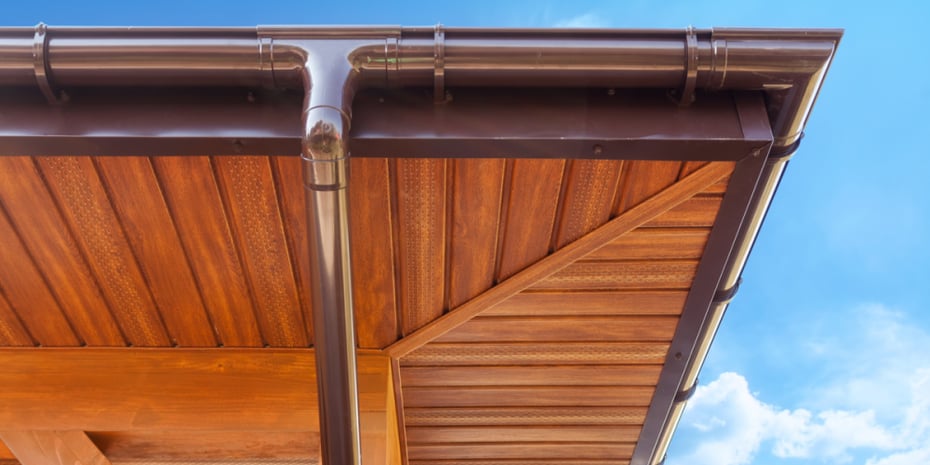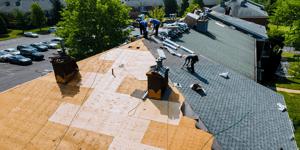Replacing gutters yourself may seem like a cost-saving option, but gutter systems come in a variety of designs and require a variety of installation methods. Some require professional fabrication and installation. Removal and reinstallation or replacement may reveal maintenance issues, like rot or other forms of water damage, and sometimes removal itself causes damage. So, this is one job that's best left to a contractor, especially if that same contractor will be repairing or replacing your roof.
Not having your gutters inspected by a professional when your roof is being replaced is like getting your oil changed and not have a professional inspect your brakes. Why not get it all done at once? Many gutter systems require removal before re-roofing, and even if they don’t, this can still be a good time to determine if repair or replacement is necessary. While you’ve got them off, you can inspect for water damage and rot and consider repainting your fascia and trim.
Is Replacing Gutters Easy?
The answer to this question can vary quite a bit, based on the material and method of installation. The gutters on your house may be made from common materials, such as vinyl (PVC), galvanized metal, or aluminum, but possibly less common materials, such as copper or even stone or wood. Some are attached to the fascia and can be removed and replaced without affecting the roof at all, while others incorporate flashing anchored beneath the roofing and require removal of at least the first row of shingles or fasteners. Some are nailed, others are screwed. Some are continuous, and others are segmented.
Removal and replacement can require varying skill levels and tools, and this work carries with it a range of insurance, safety, and liability issues. What's more, if the gutters will be reused, improper removal can cause damage and costly replacement.
Why You Ideally Want A Contractor to Remove and Reinstall Your Gutters
In view of all of this, whether you plan to temporarily remove your gutters or completely replace them, it is best to consider having your roofing contractor include it in his estimate.
You may be convinced that removing the gutters yourself will save you money, but due to the indeterminable complexities of removal and replacement and the possibility that unexpected damages to your fascia and eaves may be revealed during the process, hiring a professional is much less risky. Not only will they be responsible for proper removal, but they will also bear responsibility for any unforeseen damage that might happen.
K-Style Seamless Gutters: A Job for Contractors
Seamless gutters tend to have fewer leaks, require less maintenance, and enhance your home's curb appeal. So instead of grabbing a bunch of 8-foot sections from your local DIY store, it's best to have a contractor install a seamless solution. This is a job you will definitely want to leave to a professional, primarily because you need a special machine onsite to form the gutters. In addition to the machine itself, an efficient seamless gutter install requires additional equipment, such as run-out stands and transfer racks, that your contractor likely already has in stock.
Should You Perform Roof and Gutter Repairs When Having Your Roof Repaired or Replaced?
Since your gutters are an important part of your roofing system, including gutters and roof fixes in the scope of work is logical and cost-effective. If you’re planning extensive roofing repairs, this is also the best time to inspect, clean, repair, and maybe even replace your gutters. If a contractor has to come back at a later date to solve issues with the gutter, it will probably end up being more expensive than if he had included it in the roofing job.
Additionally, contractors often damage gutters during roofing repairs or replacement, so it’s usually best they be removed before the job and replaced after. As mentioned, any water damage or rot hidden by the gutters will then be revealed and can be remedied before replacement. Another benefit of this practice is that during replacement, proper flashing and caulking can be applied, ensuring a longer life for your roofing system as a whole.
What to Look Out for When Having Your Roof and Gutters Repaired and Replaced
Even if you’ve hired professionals for your roof and gutter replacement, it’s recommended you keep an eye out for issues that can be revealed during the removal of old roofing and gutters. Here's what to look for.
Leaks
Water stains, abnormal moisture, and rot reveal the presence of leaks. If you see these signs on the fascia or under the eaves, they may have been caused by either leaky gutters or faulty drip-edge installation. Ask your contractor to help you identify the cause and determine the best solution. Leaks are not limited to the roof, however. If you see water damage in your foundation or basement, ask your contractor to verify whether they're being caused by leaks in your gutter or downpipes.
Rot and Rust
Rot is caused by fungi that thrive in moisture. Even small leaks can cause rot, as can the presence of dampness or moisture caused by improper installation or maintenance of roofing components. The damage may be superficial or structural, so ask your contractor for input on the right remedy. Look for rust, too: rust is to metal what rot is to wood. Corrosion is sped up by moisture, whether due to an actual leak or the improper installation of components that shed moisture from a roof.
Structural Damage
Sagging sections of your roof and “spongy” movement of its substructure probably indicate structural damage beneath. This can be caused by age, defects in the materials used, or loads from snow, ice, or other natural events. Ask your contractor to help you determine the extent of the damage and options for repair.
Any part of a roof that’s designed to move moisture away can also be a vulnerability. Make sure to inspect skylights, drip edges, flashing, chimneys, and other features during the roofing process.
How Can HOVER Help?
HOVER can create an interactive 3D model of your house that can be used for measuring, designing, and estimating for gutters and other home improvement projects. Homeowners and contractors can sign up to create an account, or schedule an appointment to consult with one of our representatives.





